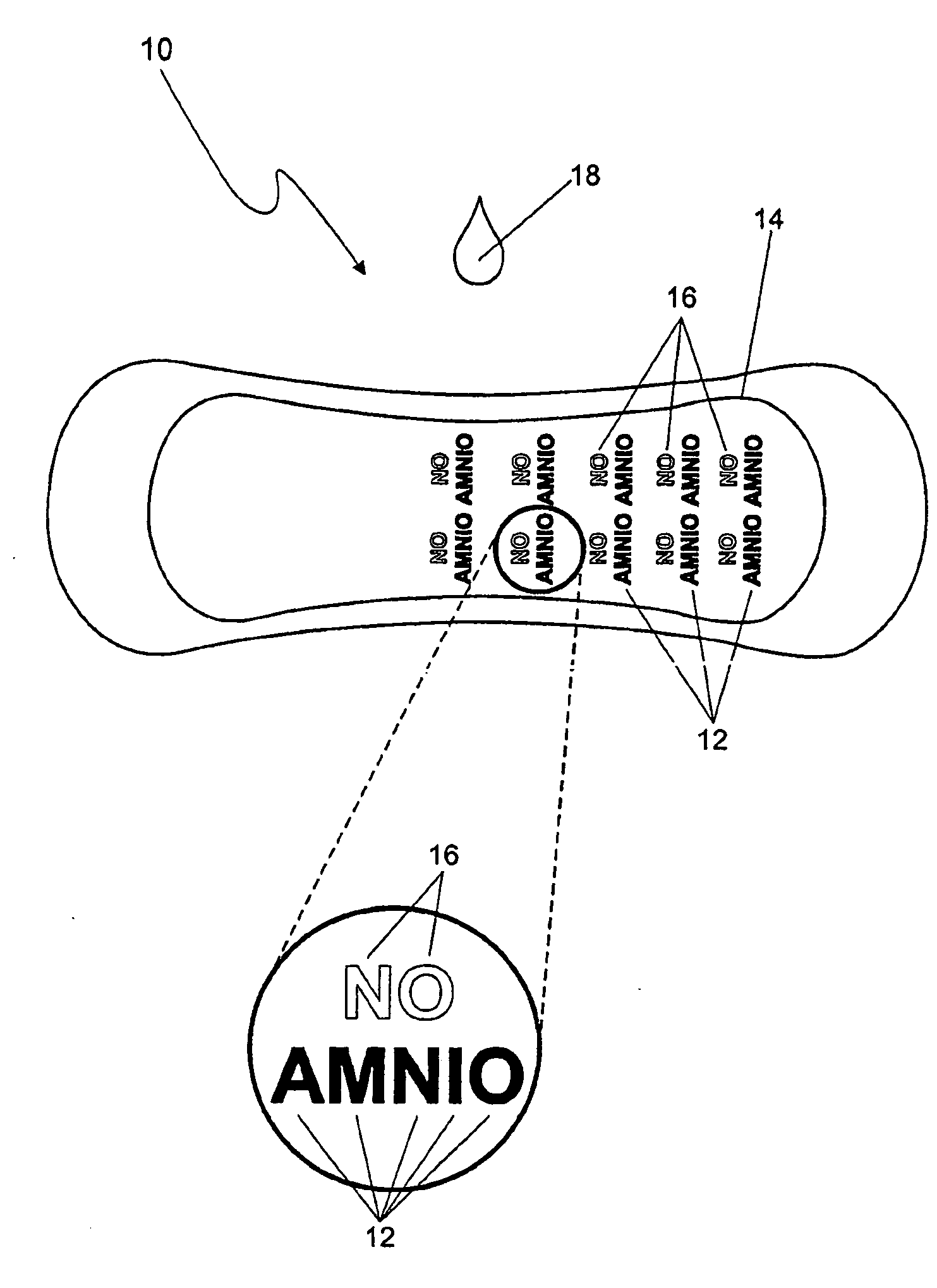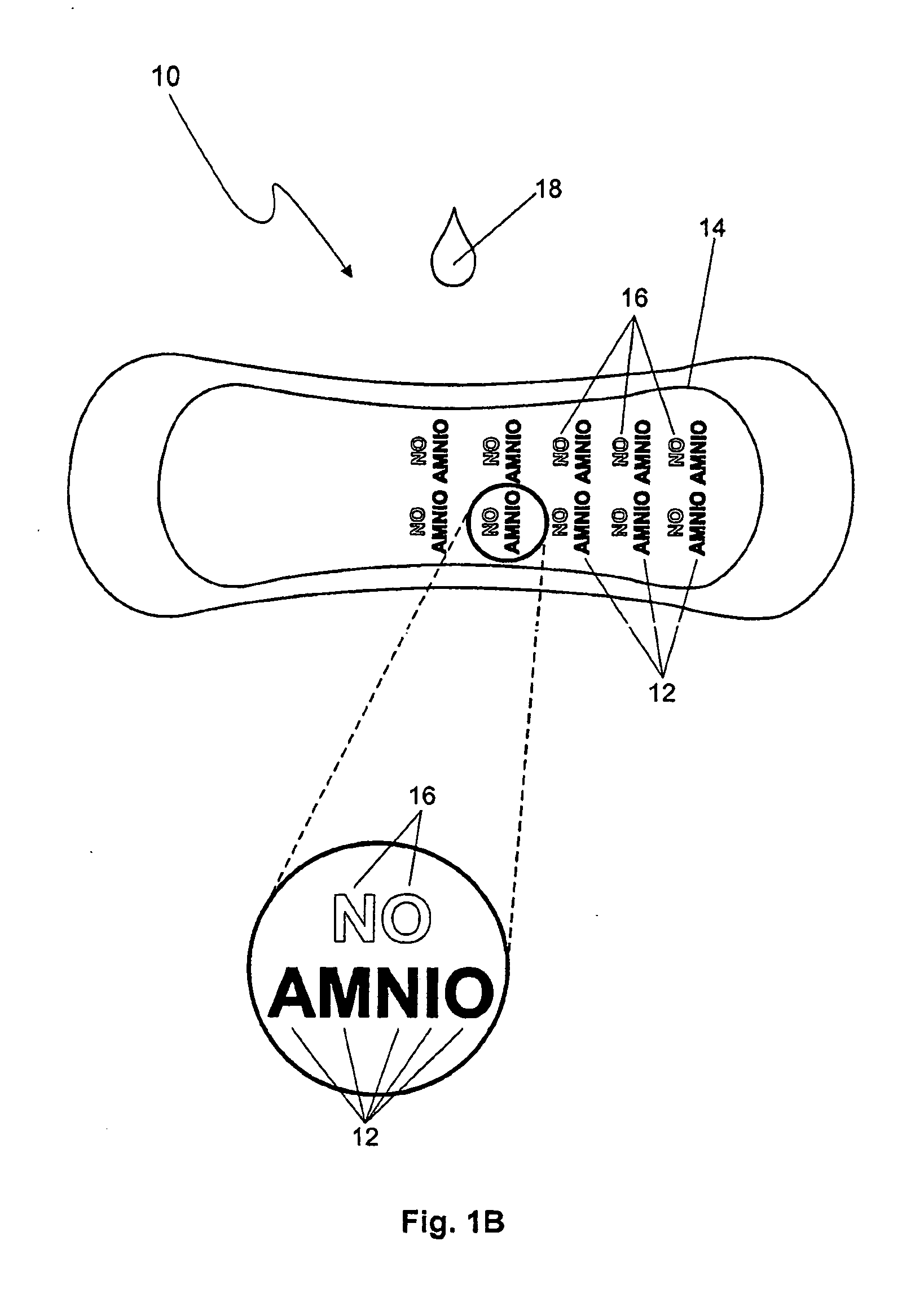Secretion-monitoring article
a secretion monitoring and article technology, applied in the field of medical diagnostics, can solve the problems of inability to readily retain a stable indication, inability and inability to easily adapt the visual indication to provide a distinct indication
- Summary
- Abstract
- Description
- Claims
- Application Information
AI Technical Summary
Benefits of technology
Problems solved by technology
Method used
Image
Examples
example 1
Reducing Erroneous Readings of Color-Changing Devices that Give an Indication of Elevated pH in the Vaginal Secretion
[0074] The following example discloses the solution to produce an indicator that needs no color-table or scale to read results, that shows the user a stable indication for a few days, and that does not leach even when in contact with liquids for any practical length of time. For the non-invasive continuous monitoring version, the invention discloses a solution to avoid false positive readings due to urine contamination.
[0075] The device is a sticker or a pantyliner that contains two different indicator strips, embedded between layers of one-way absorbent tissues. The two indicators have a color transition-point at different pH levels. The color-reactions of the two indicators also have different reversibility in vaginal secretion Vs urine.
[0076] The first indicator strip changes color to stable blue, when sensing elevated pH in vaginal secretions (pH strip). The pH...
example 2
A Device Able to Distinguish Accurately Between an Amniotic Fluid Leak or an Elevated pH Vaginal Discharged Secretion and Wetness Caused by Urine Incontinence
[0091] Due to the severe consequences of amniotic fluid leakage, pregnant women undergo heavy stress and tend to seek for a health care provider upon any wet sensation in the area of the vagina. The common ways to checks for the presence of amniotic fluid are by examining the pH of vaginal secretions with pH indicators such as nitrazine indicators, running the Fern-test or by visually identifying the source of the leakage.
[0092] Amniotic fluid has a pH level that varies between 6-8 and can be identified by a purple-blue color of a nitrazine indicator. Since urine, has a pH level that varies between 5.0-8.0, measuring pH levels as a sole criterion can mislead to erroneous decisions. As the other two ways can be performed only in clinics and hospitals, and by trained staff, there is no practical solution for home monitoring.
[0...
example 3
A Device Able to Distinguish Accurately Between Normal Urine and Infected Urine
[0115] The reoccurrence of urinary tract infections in certain patients present the need to quickly and easily diagnose whether the patient has another urinary tract infection. Presently, to determine if a patient has a urinary tract infection they must make an appointment to visit a doctor. Furthermore, if the patient is susceptible to the reoccurrence of urinary tract infections they must make periodic visits to the doctor's office to ensure that the infection has not reoccurred. Having a device that would allow the user to determine if they had a urinary tract infection again would minimize stress and time consumed by visits to the doctors office and result in quicker diagnosis of the infection, resulting in a reduction in pain suffered by the patient and a more timely treatment of the infection.
[0116] The article in this example is a diaper or a panty liner with an indicator that can distinguish bet...
PUM
 Login to View More
Login to View More Abstract
Description
Claims
Application Information
 Login to View More
Login to View More - R&D
- Intellectual Property
- Life Sciences
- Materials
- Tech Scout
- Unparalleled Data Quality
- Higher Quality Content
- 60% Fewer Hallucinations
Browse by: Latest US Patents, China's latest patents, Technical Efficacy Thesaurus, Application Domain, Technology Topic, Popular Technical Reports.
© 2025 PatSnap. All rights reserved.Legal|Privacy policy|Modern Slavery Act Transparency Statement|Sitemap|About US| Contact US: help@patsnap.com



